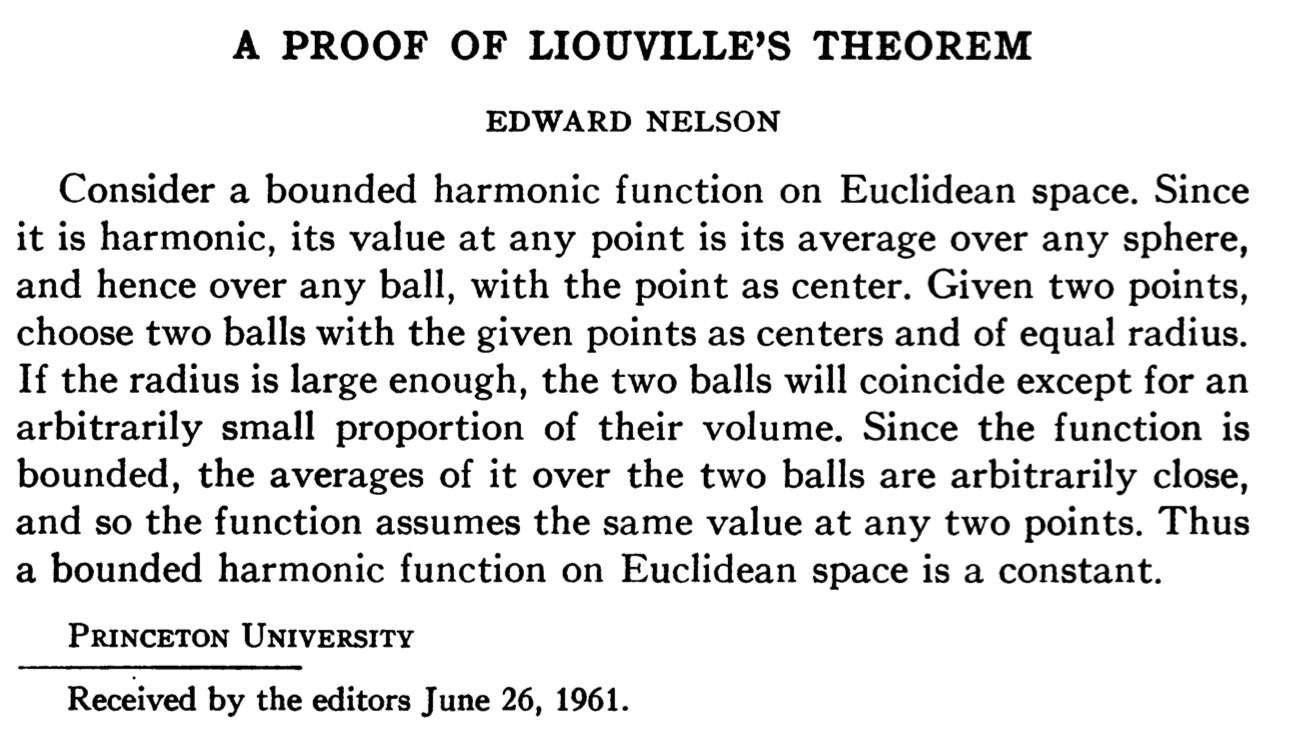Delbar and the Laplacian
A real function of two variables \(u(x, y)\) is harmonic iff it is in the kernel of the Laplacian operator: \begin{align*} \Delta u \coloneqq\qty{{\frac{\partial ^2}{\partial x^2}\,} + {\frac{\partial ^2}{\partial y^2}\,}}u = 0 .\end{align*}
\begin{align*} {\partial}\coloneqq{\partial}_z \coloneqq{1\over 2}\qty{{\partial}_x - i {\partial}_y} \quad \text{ and } \quad { \overline{{\partial}}} \coloneqq{\partial}_{\overline{z}} ={1\over 2}\qty{ {\partial}_x + i{\partial}_y} .\end{align*} Moreover, the 1-form corresponding to \(F\) can be written as \begin{align*} dF = {\partial}F + { \overline{{\partial}}}F = {\frac{\partial F}{\partial z}\,} \,dz+ {\frac{\partial F}{\partial \overline{z}}\,}\,d\overline{z} .\end{align*}
Written slightly more explicitly: \begin{align*} {\frac{\partial F}{\partial z}\,} = {1\over 2}\qty{{\frac{\partial F}{\partial x}\,} + {1\over i}{\frac{\partial F}{\partial y}\,} } && {\frac{\partial F}{\partial \overline{z}}\,} = {1\over 2}\qty{{\frac{\partial F}{\partial x}\,} - {1\over i}{\frac{\partial F}{\partial y}\,} } .\end{align*}
If \(u\) is harmonic on \(\Omega\) then \begin{align*} u(z_0) = u(x_0 + i y_0) = {1\over 2\pi r} \oint_{{{\partial}}{\mathbb{D}}_r(z_0)} u \,ds= {1\over \pi r^2} \iint_{{\mathbb{D}}_r(z_0)} u(x, y) \,dx\,dy .\end{align*}
Define \begin{align*} F(r) \coloneqq{1\over 2\pi r} \oint_{{\mathbb{D}}_r(z_0)} u\,ds= {1\over 2\pi} \int_{[-\pi, \pi]} u(z_0 + re^{it} ) \,dt .\end{align*}
Then differentiate: \begin{align*} F'(r) &= {1\over 2 \pi} \int_{[-\pi, \pi]} \cos(t) u_x(z_0 +re^{it} ) + \sin(t) u_y(z_0 + re^{it}) \,dt\\ &= {1\over 2\pi r} \oint_{{{\partial}}{\mathbb{D}}_r(z_0)}\qty{x-x_0\over r} u_x(x, y) + \qty{y-y_0\over r}u_y(x, y) \,ds\\ &= {1\over 2\pi r} \oint_{{{\partial}}{\mathbb{D}}_r(z_0)} {\frac{\partial u}{\partial w}\,} \,ds\qquad w = {\left[ {{x-x_0\over r}, {y-y_0\over r}} \right]} \\ &= {1\over 2\pi r} \iiint_{{\mathbb{D}}_r(z_0)} \Delta u \,dx\,dy\\ &= 0 ,\end{align*} where we’ve used Green’s theorem and that \(\Delta u = 0\). so \(F\) is constant. Take \(r\to 1\) to obtain \begin{align*} F(r) = {1\over 2\pi} \int_{[-\pi, \pi]} u(z_0 + re^{it}) \,ds\longrightarrow\int_{[-\pi, \pi]} u(z_0) \,ds= u(z_0) = u(x_0, y_0) .\end{align*}
An important use: if \(u\) satisfies the mean value property on every disc and is continuous, then \(u\) is automatically harmonic.
Exercises: Harmonic Functions
Show that \(f\) is holomorphic iff \({ \overline{{\partial}}}f = 0\).
\begin{align*} 2{ \overline{{\partial}}}f &\coloneqq({\partial}_x + i {\partial}_y) (u+iv) \\ &= u_x + iv_x + iu_y - v_y \\ &= (u_x - v_y) + i(u_y + v_x) \\ &= 0 && \text{by Cauchy-Riemann} .\end{align*}
Show that if \(f = u+iv\) is holomorphic then \(u, v\) are harmonic.
Idea: use Cauchy-Riemann, take further derivatives, and use equality of partials.
-
By CR, \begin{align*} u_x = v_y && u_y = -v_x .\end{align*}
-
Differentiate with respect to \(x\): \begin{align*} u_{xx} = v_{yx} && u_{yx} = -v_{xx} .\end{align*}
-
Differentiate with respect to \(y\): \begin{align*} u_{xy} = v_{yy} && u_{yy} = -v_{xy} .\end{align*}
-
Clairaut’s theorem: partials are equal, so \begin{align*} u_{xx} - v_{yx} = 0 \implies u_{xx} + u_{yy} = 0 \\ \\ v_{xx} + u_{yx} = 0 \implies v_{xx} + v_{yy} = 0 \\ \\ .\end{align*}
Show that if \(u\) is harmonic on \({\mathbf{R}}^2\) and bounded, then \(u\) is constant.
Write \(f=u+iv\) for \(v\) a harmonic conjugate of \(u\), then \(f\) is holomorphic on \({\mathbf{C}}\). Now \(e^f = e^{u+iv} = e^u e^{iv}\) and thus \begin{align*} {\left\lvert {e^f} \right\rvert}\leq {\left\lvert {e^u} \right\rvert} {\left\lvert {e^{iv}} \right\rvert} = {\left\lvert {e^u} \right\rvert} \end{align*} is bounded, so \(f\) is a bounded entire function and thus constant by Liouville.

Show that if \(u,v\) are harmonic conjugates, then
- \(u^2-v^2\) is harmonic
- \(uv\) is harmonic.
- \(u_x\) is harmonic.
Write \(f=u+iv\), which is analytic.
-
\(f^2\) is analytic, and \(f^2 = (u+iv)^2 = u^2 - v^2 + i (2uv)\), which necessarily has harmonic components.
-
Covered by the first case.
-
\(f'\) is analytic and one can write \(f' = u_x + iv_x\), which has harmonic components.
As an alternative to show that \(uv\) is harmonic directly by showing it’s in the kernel of the Laplacian. A computation: \begin{align*} \Delta(uv) &= (uv)_{xx} + (uv)_{yy} \\ &= (u_{xx}v + uv_{xx} + 2u_x v_x) + (u_{yy}v + uv_{yy} + 2u_y v_y) \\ &= (u_{xx} + u_{yy}) v + (v_{xx} + v_{yy}) u + 2(u_xv_x + u_yv_y) \\ &= (u_{xx} + u_{yy}) v + (v_{xx} + v_{yy}) u + 2(-u_x u_y + u_y u_x) && v_x = -u_y,\, v_y = u_x \\ &= (u_{xx} + u_{yy}) v + (v_{xx} + v_{yy})u \\ &= \Delta(u)v + \Delta(v)u \\ &= 0 .\end{align*}
Find a harmonic conjugate for \begin{align*} u(x, y) = x^3 - 3xy^2 -x -y .\end{align*}
The standard procedure for harmonic conjugates:
- Start with \(u\)
- Take \({\frac{\partial }{\partial x}\,}\) to get \(u_x\)
- Apply CR to get \(u_x = v_y\)
- Take \(\int \,dy\) to get \(v\), which is essentially the solution up to an unknown \(f(x)\).
- Take \({\frac{\partial }{\partial x}\,}\) to get \(v_x\) which involves \(f_x\)
- Apply CR to set \(v_x = -u_y\) and solve for \(f_x\)
- Compute \(\int f_x \,dx\) to obtain \(f(x)\).
My quick mnemonic:
First, check that \(u\) is actually harmonic: \begin{align*} \Delta u = {\frac{\partial }{\partial x}\,}(3x^2-3y^2-1) + {\frac{\partial }{\partial y}\,}(-6xy - 1) = 6x + (-6x) = 0 .\end{align*}
Standard procedure: integrate \(v_y=u_x\) with respect to \(x\), \begin{align*} v_y = u_x = 3x^2 - 3y^2 - 1 \implies v = \int u_x \,dy= 3x^2y - y^3 - y + f_1(x) .\end{align*} Now differentiate \(v\) with respect to \(x\) and set \(v_x = -u_y\): \begin{align*} v_x = 6xy + (f_1)_x = -u_y = 6xy + 1\implies f_1 = x + c_1 .\end{align*} Thus \begin{align*} v(x, y) = 3x^2y - y^3 - y + x + c_1 .\end{align*}